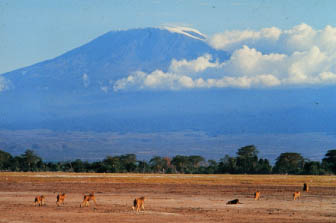|
Notes from the Field July 2001 This July, the deepening of the dry season was less acute than it often is, because the long rains from February to May were very good. However, in May and June we had an unusual number of deaths from predation. In Nyayo's Group, six animals died in June alone, and we think almost all were lost to predators, probably leopards. Among the missing were Saudi, great-great-granddaughter of Alto, and her infant Sayo. So, even though the food has been plentiful, life is never easy for the baboons of Amboseli. On the morning of the 13th of July, we saw lion footprints underneath the trees that Weaver's Group slept in. Lions are becoming more common in the last few years, after they nearly disappeared in the Amboseli basin in the early 1990's due to conflicts with Maasai people in the area. Baboons are less worried about lions than they are about leopards. Baboons are a bit too small for lions to be serious about preying on them, while they are just the right size for leopards. But we can bet that they made a lot of noise when a lion circled under their sleeping tree in the night.
|

 On
the night of 20th of July, Dubu, a young male from Viola's Group,
slept with Weaver's Group. He returned "home" to Viola's
in the morning, an hour or so after he woke up - they slept in trees
less than a kilometer away from Weaver's. This pattern of exploring
and "visiting" groups near to one's own is very common among
males nearing dispersal age (seven to eight years old), but Dubu is
pretty young to show this behavior - he just turned four in May. We
were surprised at Dubu's adventure, but we don't know whether he just
got accidentally separated from Viola's Group and slept with Weaver's
because he found them and couldn't find Viola's, or whether he purposefully
went visiting. If so, he is beginning to show dispersal-associated
behavior at the young end of the age range for dispersal in Amboseli
([
On
the night of 20th of July, Dubu, a young male from Viola's Group,
slept with Weaver's Group. He returned "home" to Viola's
in the morning, an hour or so after he woke up - they slept in trees
less than a kilometer away from Weaver's. This pattern of exploring
and "visiting" groups near to one's own is very common among
males nearing dispersal age (seven to eight years old), but Dubu is
pretty young to show this behavior - he just turned four in May. We
were surprised at Dubu's adventure, but we don't know whether he just
got accidentally separated from Viola's Group and slept with Weaver's
because he found them and couldn't find Viola's, or whether he purposefully
went visiting. If so, he is beginning to show dispersal-associated
behavior at the young end of the age range for dispersal in Amboseli
([